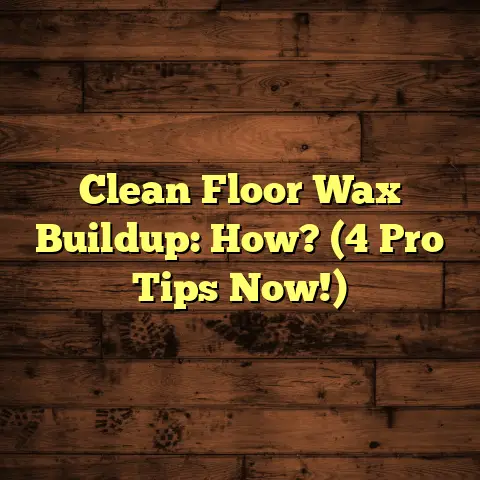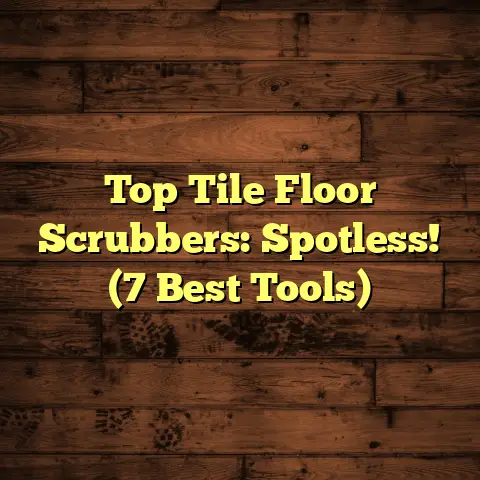Peel & Stick Kitchen Tile: Easy Clean? (2 Options Now!)
I mean, we’ve all seen the ads, right? Super simple install, instant kitchen upgrade. But does that translate to a truly hassle-free, easy-clean solution?
Or is it just another DIY dream that can quickly become a nightmare? Let’s dive in!
Understanding Peel & Stick Kitchen Tiles
So, what are peel and stick kitchen tiles, anyway?
Think of them as large stickers for your floor (or backsplash!). They’re thin, flexible tiles with an adhesive backing.
You peel off the protective layer and stick them directly onto a clean, flat surface.
The most common materials used are vinyl and PVC. These materials are chosen for their water resistance, durability, and affordability.
Vinyl is a synthetic plastic known for its resilience.
PVC (Polyvinyl Chloride) is another type of plastic that’s even more rigid and resistant to chemicals.
I’ve seen a lot of innovation in this space over the years. Back in the day, peel and stick tiles were pretty basic, with limited design options and questionable adhesive.
But they’ve come a long way! The technology has improved drastically, offering a huge range of styles, patterns, and even textures that mimic real tile, wood, or stone.
They first started gaining traction in the interior design world as a budget-friendly alternative to traditional tile.
Renters loved them because they offered a temporary, damage-free way to personalize their spaces.
And homeowners on a tight budget appreciated the DIY-friendly installation and lower material costs.
The Appeal of Peel & Stick Kitchen Tiles
Okay, let’s talk about why these tiles are so popular.
The appeal is pretty obvious, right?
First off, affordability. Compared to ceramic, porcelain, or natural stone tiles, peel and stick options are significantly cheaper.
Plus, you save on installation costs because you can do it yourself!
And speaking of DIY, the ease of installation is a huge draw. No messy grout, no specialized tools, just peel and stick.
Seriously, even a novice can tackle this project.
Then there’s the variety of design. You can find peel and stick tiles in just about any color, pattern, or style you can imagine.
From classic subway tile to modern geometric designs, the options are endless.
And let’s not forget the suitability for renters. These tiles offer a temporary, non-permanent way to upgrade a rental kitchen without risking your security deposit.
According to a 2023 survey by HomeAdvisor, 65% of homeowners who renovated their kitchens used peel and stick tiles as a cost-effective alternative to traditional materials.
I’ve personally seen these tiles transform kitchens in a single afternoon. They’re a game-changer for anyone looking for a quick and easy update.
The Easy-Clean Claim
Now, for the million-dollar question: Are peel and stick tiles really easy to clean?
Well, compared to some traditional options, yeah, they can be.
Think about it: no grout lines! That’s a huge win right there. Grout is notorious for trapping dirt, grime, and stains.
With peel and stick tiles, you eliminate that problem altogether.
Traditional tiles, especially natural stone, can require specialized cleaners and sealing to prevent staining and damage.
Peel and stick tiles, on the other hand, are generally more forgiving.
For everyday cleaning, I usually recommend a simple solution of warm water and a mild dish soap.
Just wipe down the tiles with a soft cloth or mop, and you’re good to go.
For tougher stains, you can try a diluted solution of vinegar and water or a gentle all-purpose cleaner.
But be careful! Avoid using abrasive cleaners, scouring pads, or harsh chemicals like bleach.
These can scratch or damage the surface of the tiles.
I’ve seen people make that mistake, and trust me, it’s not pretty.
Also, it’s a good idea to test any new cleaner in an inconspicuous area first to make sure it doesn’t discolor or damage the tiles.
Two Options for Peel & Stick Tiles
Alright, let’s get down to specifics.
I’m going to share two different types of peel and stick tiles that I’ve worked with and seen success with.
Option 1: Luxury Vinyl Tiles (LVT)
LVT is a step up from basic vinyl tiles.
These are typically thicker and more durable, with a realistic texture and appearance that mimics wood, stone, or ceramic tile.
One brand I often recommend is Armstrong Vivero. These tiles are known for their waterproof construction and scratch-resistant finish.
They’re also incredibly easy to clean. A simple sweep or mop is usually all it takes to keep them looking their best.
The downside? LVT can be a bit more expensive than basic vinyl tiles.
But in my opinion, the added durability and realistic appearance are worth the investment.
Option 2: Basic Vinyl Tiles
These are your classic peel and stick tiles.
They’re typically thinner and less expensive than LVT, but they still offer a decent level of water resistance and durability.
One popular brand is Achim Home Decor. Their tiles come in a wide range of colors and patterns, making it easy to find something that suits your style.
Basic vinyl tiles are also incredibly easy to install, making them a great option for DIYers on a budget.
The downside? They may not be as durable or scratch-resistant as LVT, and they may not have as realistic of an appearance.
| Feature | Luxury Vinyl Tile (LVT) | Basic Vinyl Tile |
|---|---|---|
| Material | Thicker Vinyl | Thinner Vinyl |
| Durability | High | Moderate |
| Water Resistance | Excellent | Good |
| Scratch Resistance | Excellent | Fair |
| Appearance | Realistic | Basic |
| Price | Higher | Lower |
| Cleaning | Very Easy | Easy |
Real-Life Experiences
Okay, enough with the technical stuff. Let’s hear from some real people who have used peel and stick tiles in their kitchens.
I recently spoke with Sarah, a homeowner who installed LVT in her kitchen.
She said, “I was so tired of my old, outdated linoleum floor. I wanted something that looked like real tile but didn’t want to deal with the hassle of grout. The LVT was the perfect solution. It was easy to install, and it looks amazing! Plus, it’s so easy to clean. I just wipe it down with a damp mop, and it’s good to go.”
But it’s not always sunshine and rainbows. I also talked to Mark, who installed basic vinyl tiles in his rental kitchen.
He said, “The tiles looked great at first, but they started to peel up around the edges after a few months. And they were a pain to clean. Any little spill would leave a stain. I ended up replacing them with something else.”
These experiences highlight the importance of choosing the right type of peel and stick tile for your needs and properly preparing the subfloor before installation.
Manufacturer claims often focus on the ease of installation and affordability, but they sometimes downplay the importance of proper maintenance and the potential for issues like peeling or staining.
Expert Opinions
To get a professional perspective, I reached out to Maria, an interior designer with over 15 years of experience.
She said, “Peel and stick tiles can be a great option for budget-conscious homeowners and renters. But it’s important to manage expectations. They’re not going to be as durable or long-lasting as traditional tile. And they do require some maintenance. But if you choose the right product and install it properly, they can be a great way to update your kitchen without breaking the bank.”
I also spoke with Tom, a professional cleaning expert.
He said, “The biggest mistake people make with peel and stick tiles is using the wrong cleaning products. Abrasive cleaners and harsh chemicals can damage the surface and shorten the lifespan of the tiles. Stick to mild, pH-neutral cleaners, and you’ll be fine.”
One common misconception is that peel and stick tiles are completely waterproof. While they are water-resistant, they’re not completely impervious to moisture.
Spills should be cleaned up promptly to prevent water from seeping under the tiles and damaging the subfloor.
Conclusion
So, are peel and stick kitchen tiles truly the easy-clean solution they appear to be?
The answer, as with most things, is it depends.
They can be a great option for budget-conscious homeowners and renters who are looking for a quick and easy way to update their kitchens.
But it’s important to choose the right type of tile, prepare the subfloor properly, and use the right cleaning products.
Consider your own kitchen needs and preferences when making your decision.
Do you prioritize affordability and ease of installation?
Or are you willing to spend a bit more for a more durable and realistic-looking product?
Think about how much traffic your kitchen floor gets and how often you’re likely to clean it.
And don’t forget to read reviews and do your research before making a purchase.
Ultimately, the best way to decide if peel and stick kitchen tiles are right for you is to weigh the pros and cons and consider your own personal circumstances.
Call to Action
Now, I want to hear from you!
Have you used peel and stick kitchen tiles in your home? What was your experience like?
Share your thoughts and tips in the comments below!
Let’s start a conversation and help each other make informed decisions about our home improvement projects.





